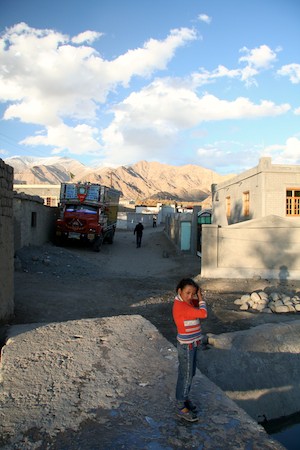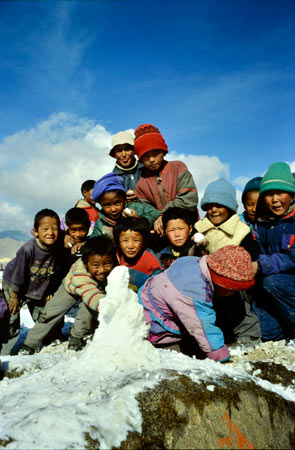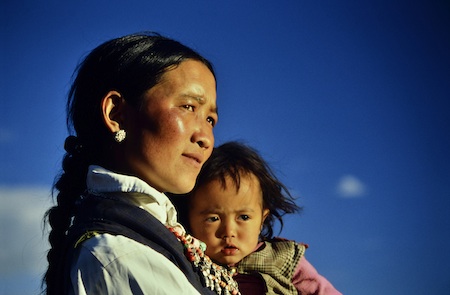Today

Around seven thousand tibetan refugees live in Ladakh, a vast majority of them originating from Ngari, which makes them culturally very close to their ladakhi hosts. More than five thousand of them live in the small town of Choglamsar, in the Leh valley, while the others live in the Chang Thang area, near the tibetan border.
The tibetan population of Choglamsar lives in an urban environment that reminds of the towns of ancient Tibet : clusters of cubic houses with flat-roofs. However, most of its inhabitants are former nomads and farmers - and their offspring born in Ladakh.
Various institutions are based in Choglamsar: the tibetan government's representative, the health center, the retirement home, Women's Association, Tibetan Youth Congress, and the massive school complex, where tibetan children get a modern western education coupled with the teaching of tibetan written language, history and religion, plus, for some students, tibetan crafts and arts.
Few exiles in Choglamsar are engaged in rural activities. Most of the refugee population live from urban types of jobs : some are working for the various tibetan institutions, some run businesses (groceries, restaurants, guest-houses, etc...) and the majority depend on seasonal jobs such as construction or road building.
The 1500 tibetans who live on the plateau of Chang Thang are in a totally different situation: they are the only refugees in India who can maintain a lifestyle similar to rural Tibet.
These nomadic shepherds share the pastureland of the ladakhi nomads – which is not without tensions – and live under the tent throughout the year, taking care of their herds of sheep, goats, yaks and dzos.
A community of muslim tibetans took refuge further west, near Kargil, the population of which is predominantly muslim.

Tomorrow
Most of the present refugee population was born in Ladakh and has never seen Tibet. Though they are in many ways more familiar with the indian and western ways of life than with the culture of their parents, who were farmers and nomads, they definitely remain Tibetan. They form a new sociocultural group : the modern, urban, exiled tibetans. Moreover, they clearly identify themselves as tibetans, and many hope to "return" to Tibet one day, if Tibet recovers its independance.
Some refugees sometimes wonder if they should get back to their ancestors' land without waiting. "I would do better in Tibet, explains Tsewang Dorjee. The land is vast, I would be free to expand my herd, unlike here in Ladakh where we are limited by the authorities due to demographic pressure in the pastureland."
Tenzin Niendak sneaked into Tibet and confirms this impression : "I saw many nomads there making a living, they seemed to have some religious freedom, I felt like staying there to raise animals..."
Even among the elders, those who were born in Tibet and escaped decades ago, the hope to return to their homeland is there. Not always : Khampa Dhadul, born in Kham, doesn't believe he will return there : "I have no more hope to go back to Tibet. I am preparing to die here in India, even though I would rather die in my homeland..."
On the other hand, Jampa Yangdol, born in Western Tibet in the thirties : "I am very optimistic for the future of my country. Thanks to the Dalai Lama and foreign help, I will die in Tibet." "We might return home very soon, continues her friend Jangchup Dolma, maybe in two or three years." "I still hope to return to Tibet, says Jangchup Wangmo, another old woman from Choglamsar. Deep within me, I want to return as soon as possible."
